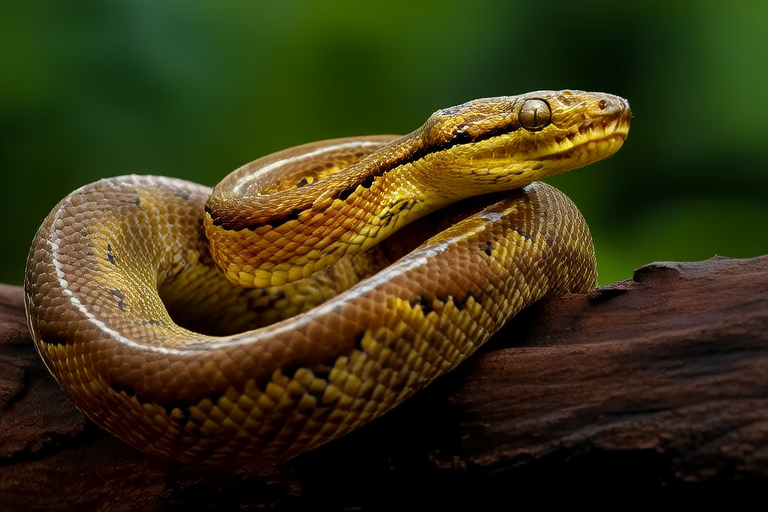The Golden Pythons: A Luminous Journey Through Myth and Reality
The golden python, also known as the blood python or Python curtus, is a species of snake that has captured the imagination of many for centuries. This captivating reptile, with its striking golden hue, has been the subject of numerous myths and legends. In this article, we will explore the unique characteristics, myths, and scientific facts surrounding golden pythons. From their luminous appearance to their behavior, we will delve into every aspect of these fascinating creatures.
The Luminous Appearance of Golden Pythons
Golden pythons are renowned for their vibrant golden coloration, which can range from a pale yellow to a deep orange. This luminous appearance is not just a matter of aesthetics; it serves a functional purpose in their natural habitat. The golden sheen helps them blend in with their surroundings, making them nearly invisible to predators and prey alike. Their scales are smooth and glossy, reflecting light in such a way that they seem to glow, especially when sunlight filters through the dense foliage of their native environment.
Habitat and Distribution
Native to Southeast Asia, golden pythons are found in the tropical rainforests of Malaysia, Indonesia, and Thailand. They thrive in humid, warm environments, often near rivers, swamps, and marshes. These areas provide the perfect conditions for the golden pythons, offering both cover and ample food sources. The dense vegetation and water bodies create an ideal ecosystem where these snakes can hunt and hide effectively.
Diet and Feeding Habits
Golden pythons are carnivorous and have a diet that consists mainly of small mammals, birds, and occasionally amphibians. They are ambush predators, relying on their ability to remain motionless for extended periods, waiting for prey to come within striking distance. Once prey is detected, the golden python strikes with incredible speed, constricting its victim until it suffocates. The snake then swallows its prey whole, a process that can take several hours. Despite their relatively small size compared to other python species, golden pythons are formidable hunters, capable of taking down prey much larger than themselves.
Behavior and Social Structure
Golden pythons are solitary creatures, spending most of their time alone. They are primarily nocturnal, active during the night when temperatures are cooler and prey is more active. During the day, they often seek shelter in burrows, hollow logs, or dense vegetation. Although they are generally shy and elusive, golden pythons can become aggressive if threatened or provoked. Their defensive behavior includes hissing, flattening their bodies to appear larger, and striking if necessary. Despite their solitary nature, golden pythons are known to exhibit some social behaviors during mating season, when males may engage in combat to win the favor of a female.
Myths and Misconceptions
Throughout history, golden pythons have been the subject of numerous myths and misconceptions. One common myth is that they are venomous, which is false. Golden pythons, like all non-venomous snakes, rely on constriction to subdue their prey. Another misconception is that they are dangerous to humans. While they can be aggressive if cornered, golden pythons are not considered a threat to humans unless provoked. In reality, they play a crucial role in maintaining the balance of their ecosystems by controlling populations of rodents and other small animals.
Care in Captivity
For those interested in keeping golden pythons as pets, it is essential to understand the specific requirements of their care. Golden pythons require a spacious enclosure with appropriate temperature and humidity levels. The enclosure should mimic their natural habitat as closely as possible, providing hiding spots and climbing structures. A heat lamp or under-tank heater can be used to maintain the required temperature gradient, typically ranging from 80 to 90 degrees Fahrenheit. Humidity should be kept between 60% and 80%, which can be achieved through regular misting or the use of a humidifier. It is also important to provide a shallow water dish for drinking and soaking. In terms of diet, captive golden pythons should be fed appropriately sized rodents, such as mice or rats, every one to two weeks.
Conservation Efforts
Unfortunately, golden pythons face numerous threats in the wild, including habitat loss, poaching for the pet trade, and illegal hunting. Conservation efforts are crucial to ensure the survival of this species. Organizations and wildlife sanctuaries are working tirelessly to protect golden pythons and their habitats. Some initiatives focus on raising awareness about the importance of preserving these snakes and their ecosystems, while others aim to regulate the pet trade and prevent over-exploitation. By supporting these conservation efforts, we can help ensure that future generations will continue to marvel at the beauty and mystery of golden pythons.
Conclusion
The golden python is a remarkable creature, both in appearance and behavior. Its luminous golden sheen, combined with its stealthy hunting techniques, makes it a true marvel of nature. While myths and misconceptions abound, the scientific facts reveal a fascinating species that plays a vital role in its ecosystem. Whether encountered in the wild or observed in captivity, golden pythons continue to captivate and inspire awe in all who encounter them. By understanding and appreciating these snakes, we can contribute to their conservation and ensure their continued existence for years to come.
